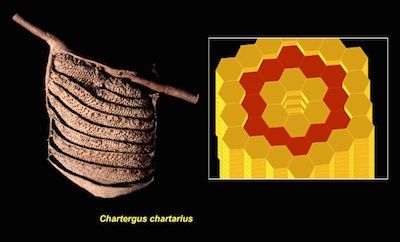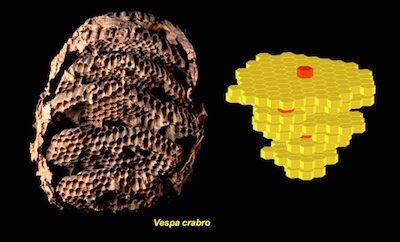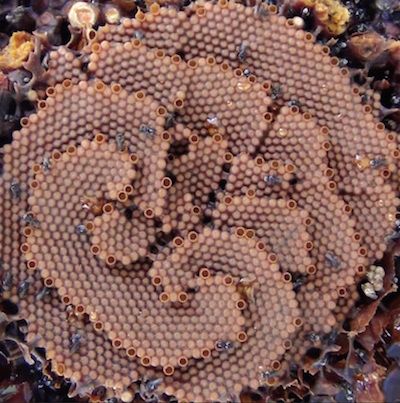A book published 100 years ago by a Scottish zoologist named D’Arcy Wentworth Thompson is one of the most remarkable scientific works of the 20th century. Called On Growth and Form, it was and remains sui generis. A blend of natural history, mathematics, physics and engineering, it offered a very different take on life from the Darwinian viewpoint favoured by Thompson’s contemporaries. Instead of explaining all shape and form in biological organisms by an appeal to its adaptive evolutionary function (torpedo shapes are optimal for fish swimming though water and so on), On Growth and Form asserted that living forms are best understood as diagrams of the forces that act on them.
As Thompson put it: "Cell and tissue, shell and bone, leaf and flower, are so many portions of matter, and it is in obedience to the laws of physics that their particles have been moved, moulded and conformed."
This quote tells you something else about On Growth and Form: it is a jewel of scientific writing. The eminent British biologist Peter Medawar called it “beyond comparison the finest work of literature in all the annals of science that have been recorded in the English tongue.” The polymathic Thompson was also a distinguished classicist (during his studies at Cambridge University he supported himself by teaching Greek), and it shows.
It’s not easy to sum up what you’ll find in On Growth and Form, except to say that it is as full of wonders as a Renaissance cabinet of curiosities. Here is maths applied to the spiraling arrangement of seeds in a sunflower head, which turns out to be related to a series of numbers called the Fibonacci series known at least since the thirteenth century. There you find dinosaur skeletons analysed according to the same engineering principles used to plan the Forth Bridge near Thompson’s home city of Edinburgh. Here are more spirals: the so-called logarithmic spiral that defines the shapes of animal horns and snail shells, which encodes the allegedly “perfect” proportions called the Golden Mean. There, jellyfish shapes are compared to splashes in milk, and the trellis-like bony “exoskeletons” of microscopic sea creatures are explained using the geometric theories of polyhedra written down by Euclid.
Behind it all is the message that shape, form and pattern in the natural world is not arbitrarily sculpted by Darwinian evolution for adaptive supremacy, but follows deeper mathematical laws running through the living and non-living worlds alike. Thompson sometimes implied that this view was an alternative to Darwinism; it’s now better seen as a complement to it. There are deep ordering principles to natural law that will, for example, make the roughly hexagonal network of cracks in the basalt pillars of the Giant’s Causeway resemble the network of veins in a dragonfly wing. But natural selection will take advantage of these when it can.
I have been enthralled by this stuff ever since I wrote a book on natural pattern formation in 1993 that attempted to bring On Growth and Form in line with contemporary thinking about complexity, fractals and self-organisation in nature. Some of it is outlined in a programme that I made recently for BBC Radio 4, broadcast this week. I am taking part in centenary events all of this year, including a major gathering in Leiden in October. So it was an educational exercise in humility when I discovered recently that I’d been ignorant all this time of one of the most remarkable examples of pattern that nature offers.
In a PhD thesis called Basic Forms and Nature sent to me by Markus Rissanen, a recent arts graduate at the University of the Arts Helsinki, I found amongst the familiar snowflakes and fractal branches an image I could scarcely credit: a bee’s comb in the shape of a perfect spiral.
This, the caption informed me, is the nest of the Australian stingless honey-producing bee Tetragonula carbonaria. A quick Google confirmed the structure as genuine, and I duly tweeted the image. Within a couple of days the tweet had nearly 10,000 likes—the kind of response I thought only JK Rowling could command. These spiral bees clearly struck a chord.
![The spiral comb of the Australian stingless bee Tetragonula carbonaria. Image: Tim Heard, The Australian Native Bee Book [http://www.nativebeebook.com.au/].](https://media.prospectmagazine.co.uk/prod/images/gm_preview/afd31d7290e0-unknown-1.jpeg)
How do the bees do it? At least I wasn’t entirely clueless about that. Several insects construct intricate dwellings, such as the labyrinthine, cathedral-like mounds of termites and the diverse layered nests of wasps. These structures are classic examples of spontaneous self-organisation. None of the insects has a blueprint somehow genetically encoded in their tiny brains. Instead, each individual labours to build cells or tunnels of mud, wax or chewed-up fibres according to a set of simple rules that require the insect only to take account of its immediate environment. For some insects that activity is regulated by pheromones exuded by individuals and wafted in the air. Wasps and bees seem to build their cells for storing honey or larvae by extending the edges of the existing comb or nest, with no obvious regard to what the whole structure looks like.
The regular hexagonal array of cells made by the common honeybee was a source of admiration to the geometrically conscious ancient Greeks. Charles Darwin considered it a perfect example of natural selection, pointing out that the hexagonal cross-section is the one that uses the least wall surface, and thus the least amount of wax, to fill up a layer with cells of the same size and shape. Since wax costs metabolic energy for the bee, he said, “the comb of the hive-bee, as far as we can see, is absolutely perfect in economizing wax and labour”—just as his theory would lead us to expect.
D’Arcy Thompson demurred, pointing out that this array of hexagons is seen in plenty of non-living systems too (such as a layer of bubbles) and is probably just caused by the physical forces at play: in this case, the surface tension pulling on the soft wax. “The bee makes no economies,” he said.
"That the beautiful regularity of the bee’s architecture is due to some automatic play of the physical forces, and that it were fantastic to assume that the bee intentionally seeks for a method of economizing wax, is certain."
Remarkably, this argument continues today. Some researchers assert that surface tension alone does shape the comb, at least in the initial stages; others point out that honeybees put the wax in place a flake at a time and work it into shape. Biologists Benjamin Oldroyd of the University of Sydney in Australia and Stephen Pratt of Arizona State University, both specialists in the social dynamics of bees, say that “Detailed observation of building bees makes clear that they actively bite, form, and plane the developing cells, rather than forming a passive matrix around which wax flows.” So here, then: Darwin 1, Thompson 0.
But what about those spirals? This is where D’Arcy Thompson’s book turns out to be so prescient. There’s no sign in On Growth and Form that he knew about the astonishing architecture of T. carbonaria, but you can be sure that, if he had, he would have doubted that the bees were born with spiral blueprints in their mind. He would have regarded the spiral form as what in today’s language is called an emergent property of the process through which the comb (a brood comb in this case, used to store larvae not honey) grew. In the catchphrase widely attributed to Thompson (although there is no record of his ever having said it), things are the way they are because they got that way. Form follows growth, not function.
What rules of hive-building, though, will give you a spiral? That’s not as mysterious as it might seem, as a paper by Oldroyd and his coworkers explains. (This paper, it turns out, was the source of the lovely image I tweeted, and which you see here.) The idea is that the bees are programmed—to what extent it’s genetic hardwiring and to what extent learned conditioning is another debate—to place a new cell next to existing ones according to some simple rules. The construction of the comb or nest then becomes what computer scientists would call algorithmic: a systematic, step-by-step process in which the outcome of each step is dictated by the ones that came before. Entomologists call such a procedure “stigmergy.”
The diverse nest structures of so-called paper wasps—members of the genus Polistes, which build with chewed up fibrous material that dries to “paper”—can be explained on that assumption. Each species has a different set of rules for where to add the next cell: for example, that the insects will preferentially fill in gaps in an existing layer of hexagons where three sides of the cell are already built, rather than adding a cell that shares only one wall with those made previously. Different kinds of preference give different nest shapes.



Oldroyd and his colleagues tried out this same approach for the Australian stingless bees, in particular comparing the spirals of T. carbonaria with the more clumpy brood comb of Tetragonula hockingsi. After watching the two types of bee closely as they went about their comb-building work, the researchers proposed a set of rules each species followed. For T. carbonaria, the crucial rule is that each cell—these bees make them cylindrical, but packed in the familiar hexagonal arrangement like oranges in a greengrocer’s store—is built slightly higher than the ones before it, causing a spiral-like ascent of the comb in either a clockwise or anticlockwise direction, at random.
![The core of the spiral in a T. carbonaria comb. Image: Tim Heard, The Australian Native Bee Book [http://www.nativebeebook.com.au/].](https://media.prospectmagazine.co.uk/prod/images/gm_preview/b4044a4cda7b-unknown-7.jpeg)
The important point is that these rules don’t prescribe a spiral: you wouldn’t necessarily guess just from reading them that the result is going to be a spiral as perfect as that of a coil of rope. It’s only when the researchers carry out simulations of comb construction on the computer, bound by the rules they imposed, that they see the regular spiralling shape.
There’s one small corollary from this idea. A remarkable number of those who retweeted the image of the T. carbonaria nest asked whether, or simply asserted that, the spiral would rotate in the other direction if the Australian bees were brought to the northern hemisphere. The notion here is that somehow the spiralling is like that of tropical cyclones, the great whirlpools in the atmosphere that create hurricanes. Those do indeed spiral in opposite directions between the two hemispheres, because the spiralling is induced by the so-called Coriolis force caused by the rotation of the Earth: a force that acts in opposite directions north and south of the equator. At much smaller scales the Coriolis force is tiny, and is overwhelmed by random currents that make bath water spiral in random directions down the plughole. (Whether the vortices would still be random if all such currents were eliminated remains contentious; getting rid of them is all but impossible.)
But there is no reason why Coriolis forces should act at all on the bees, let alone why it might be big enough to influence their comb construction. At any rate, the Australian bees do indeed make spiral combs turning in both directions, as the photos show. In some rare cases they might make twinned spirals rotating in opposite directions—a truly otherworldly structure—as well as less regular combs with many small nascent spirals, looking almost like a weird kind of fungus.

And finally: why? Does the spiral shape serve any adaptive function, as Darwinians would expect (or perhaps just assume)? Or is the pattern, as D’Arcy Thompson would have argued, just an incidental consequence of growth? No one knows for sure. Spiral combs are rare, though: Oldroyd’s collaborator Tim Heard says that only the one species out of 11 stingless bees in Australia does so, and he knows of a very few other examples in Asia (Tetragonula biroi) and the Americas (Oxytrigona tataira). Heard says it’s possible to imagine an adaptive function: the spirals might promote good air circulation and control temperature, humidity and pheromone dispersal, as well as giving the bees themselves more freedom of movement.
Perhaps. But my instinct is that natural selection wouldn’t be sensitive to such fine distinctions, not least because the spiral combs themselves take such diverse forms. Here at least, I’m with Thompson.












